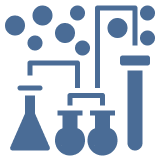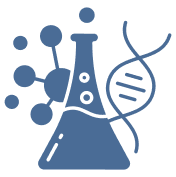
Biochemistry Homework Help | Biochemistry Assignment Help
Access uninterrupted biochemistry homework help on TutorBin to enhance your subject proficiency and academic success.

Trusted by 1.1 M+ Happy Students

Biochemistry Homework Help - For Achieving Academic Excellence
Starting to learn about biochemistry in academics opens doors to the captivating world of chemical processes within living organisms. This field can be challenging for students at all levels, from biomolecules to genetic pathways. Understanding protein structures, enzyme mechanisms, and cellular signaling pathways can seem overwhelming. The complexity of biochemistry often creates obstacles, especially since students must grasp both small and large-scale cellular processes. The abstract nature of these concepts can further make learning challenging and hamper the journey of many dedicated learners. But fear not. TutorBin biochemistry homework help is here to light up the path. Experienced tutors on our platform provide clear explanations, interactive learning, and personalized assistance to help students master biochemistry.
TutorBin biochemistry homework helpers aim to simplify this intricate subject. Our tutors navigate students through intricate topics, from DNA replication to metabolic pathways, deconstructing them into manageable learning components. With 24/7 availability and interactive sessions, TutorBin provides an immersive learning environment. Conquer the challenges of biochemistry with TutorBin and set out on a path toward academic excellence.
Biochemistry Homework Help - Best Online Help For Students
Biochemistry can be tricky for students, as it's all about understanding how life works at its basic level. At TutorBin, we're here to provide the best online help, customized for students dealing with important biochemistry concepts. Our skilled biochemistry tutors know the challenges you face when studying small building blocks of life (like biomolecules), how cells use energy (metabolic pathways), and how enzymes perform their functions.
Our specialized biochemistry tutors are dedicated to providing clear guidance that fits your learning style. Whether you're figuring out how DNA copies itself or unravelling how proteins are made, our tutors are here to support you through your studies.
We don't just give you simple steps; we want you to understand biochemistry's main concepts. Our tutors break down challenging concepts, explain how things work behind the scenes, and guide you through the steps of life's chemical reactions. We strongly believe that once you master these essential basics, you'll not only do well with assignments but also have a strong foundation for understanding biochemistry throughout your studies and beyond. With our expert help, tackling the challenges of biochemistry becomes doable, and you'll have the confidence to succeed in your studies.
Biochemistry Homework Help - Who Can Seek Help Online?
Our biochemistry homework help is tailored for students across various levels of education. Whether you're a high school student grappling with the basics or a college scholar diving deep into advanced biochemistry topics, our biochemistry tutors are here to assist you on your learning journey.
Here's who can benefit from our expert biochemistry help:
1. High School Students: If you're just starting to explore the world of biochemistry, our biochem tutors can provide clear explanations and step-by-step guidance on foundational concepts. Whether it's understanding the structure of molecules or grasping the basics of metabolism, we're here to make learning easier.
2. College Scholars: For students pursuing higher education in biochemistry, our tutors are well-equipped to assist with more advanced topics. From diving into intricate biochemical pathways to analyzing enzyme kinetics, we offer targeted help to ensure you confidently navigate these complex subjects.
3. Undergraduate and Graduate Students: Whether you're majoring in biochemistry or taking it as a part of your curriculum, our tutors have the expertise to assist you. We can aid in understanding research papers, conducting laboratory analyses, and clarifying complex biochemical theories.
4. PhD Researchers: If you're in the advanced stage of your academic journey and engaged in cutting-edge biochemistry research, our tutors are here to provide guidance. We can assist with your research, help you analyze data, and offer interpretation. Our support extends to refining your ideas and contributing to your research process.
Biochemistry Tutors Online - Is It Worth To Hire Them?
At TutorBin, our biochemistry tutors are meticulously selected based on their academic credentials and practical expertise. With a deep understanding of the subject, they excel in delivering a clear and engaging manner. Seeking guidance from these specialists can significantly enhance your grasp of biochemistry.
Collaborating with our online biochemistry tutors provides multifaceted advantages. From targeted subject guidance to enhanced learning capacity, their expertise proves invaluable. Their student-friendly approach, command over biochemistry, and unwavering support inspire confidence and trust in your academic journey. Invest in their guidance to navigate the complexities of biochemistry effectively.
Do My Biochemistry Homework
Challenges Where Students Need Biochemistry Assignment HelpStruggling with stacks of biochemistry assignments? Don't worry! With our "do my biochemistry homework" assistance, you can wave goodbye to assignment stress. Just submit your tasks, and our experts will ensure prompt and accurate solutions, helping you secure the grades you deserve.
Students seek help with biochemistry homework for several reasons:
1. Complex Concepts: Biochemistry can feel like diving into a maze of intricate pathways, molecular structures, and interactions. Our expert guidance makes these puzzling concepts crystal clear.
2. Diverse Topics: Biochemistry covers a broad spectrum from enzymology to metabolism and genetics. We help you connect the dots between these subjects so everything clicks into place.
3. Chemistry-Biology Fusion: Biochemistry blends the best of chemistry and biology. If merging these two worlds leaves you puzzled, our tutors are here to bridge the gap.
4. Technical Language: The specialized terms in biochemistry can initially feel like a foreign language. Don't let them intimidate you – we'll guide you through until they become second nature.
5. Lab Techniques: Hands-on experiments are expected in biochemistry, but they can be tricky. We'll help you design experiments, analyze data, and make sense of your results.
6. Problem Solving: Biochemistry is like solving intricate puzzles. Our step-by-step explanations will light the way if you find yourself lost in the maze of processes and reactions.
7. Math Concepts: Numbers and biochemistry go hand in hand. If you're grappling with math-related aspects like enzyme kinetics, we'll break it down so it's easy to understand.
8. Molecule Visualization: Imagine trying to understand 3D molecular structures – it's like deciphering a secret code. Let us be your decoder and guide you through these visual challenges.
9. Doubt Clarification: Confused about a specific topic? Don't let doubts linger – ask us. We'll provide clear answers that illuminate the path to understanding.
Biochemistry Topics & Concepts Covered
| TOPICS | CONCEPTS |
|---|---|
| Biomolecules | Proteins, Nucleic Acids, Lipids, Carbohydrates |
| Enzymes | Enzyme Kinetics, Inhibition, Catalysis |
| Metabolism | Glycolysis, TCA Cycle, Oxidative Phosphorylation |
| Molecular Genetics | DNA Replication, Transcription, Translation |
| Cell Signaling | Signal Transduction Pathways, Cellular Communication |
| Biochemical Pathways | Biosynthesis of Macromolecules, Metabolic Pathways |
| Protein Structure & Function | Primary, Secondary, Tertiary, Quaternary Structure |
| Enzyme Mechanisms | Active Sites, Substrate Binding, Catalytic Reactions |
| Bioenergetics | ATP, Thermodynamics, Energy Conversion |
| Carbohydrate Metabolism | Glycogenesis, Glycogenolysis, Gluconeogenesis |
| Lipid Metabolism | Fatty Acid Synthesis, β-Oxidation, Lipid Signaling |
| Amino Acid Metabolism | Amino Acid Catabolism, Biosynthesis, Urea Cycle |
| DNA Replication & Repair | DNA Polymerases, Proofreading, Mismatch Repair |
| RNA Transcription & Processing | Promoters, RNA Splicing, Ribosome Biogenesis |
| Protein Synthesis | Translation Initiation, Elongation, Termination |
| Cell Cycle & Division | Cell Cycle Phases, Cell Cycle Regulation |
| Hormones & Signaling Peptides | Endocrine Signaling, Hormone Classes, Signal Cascade |
| Membrane Structure & Function | Fluid Mosaic Model, Transport Mechanisms |
| Enzyme Regulation | Allosteric Regulation, Covalent Modification |
| Biochemical Techniques | Spectroscopy, Chromatography, Electrophoresis |